2023 HYUNDAI IONIQ 6 roof
[x] Cancel search: roofPage 523 of 582

9
9-7
• Check for fluid leaks under your vehicle (water dripping from the air
conditioning system during or after use
is normal).
At least monthly:
• Check coolant level in the coolant reservoir.
• Check the operation of all exterior lights, including the stoplights, turn
signals and hazard warning flashers.
• Check the inflation pressures of all tires including the spare for tires that are
worn, show uneven wear, or are
damaged.
• Check for loose wheel lug nuts.
At least twice a year: (for example,
every Spring and Autumn)
• Check radiator, heater and air conditioning hoses for leaks or
damage.
• Check windshield washer spray and wiper operation. Clean wiper blades
with a clean cloth dampened with
washer fluid.
• Check headlight alignment.
• Check the seat belts for wear and function.
At least once a year:
• Clean body and door drain holes.
• Lubricate door hinges and hood hinges.
• Lubricate door and hood locks and latches.
• Lubricate door rubber weather strips.
• Check the air conditioning system.
• Inspect and lubricate shift gear linkage and controls.
• Clean the battery (12 V) and terminals.
• Check the brake fluid level.
Scheduled Maintenance
Services
Follow Normal Maintenance Schedule if
the vehicle is usually operated where
none of the following conditions apply. If
any of the following conditions apply, you
must follow the Maintenance Under
Severe Usage Conditions.
• Repeated driving short distance of less than 5 mi. (8 km) in normal temperature
or less than 10 mi. (16 km) in freezing
temperature
• Driving on rough, dusty, muddy, unpaved, graveled or salt-spread roads
• Driving in areas using salt or other corrosive materials or in very cold
weather
• Driving in heavy dust condition
• Driving in heavy traffic area with the ambient temperature higher than 90 ºF
(32 ºC) while consuming more than 50%
of electric energy.
• Driving on uphill, downhill, or mountain roads repeatedly
• Towing a trailer or using a camper, or driving with loads on the roof
• Driving as a patrol car, taxi, other commercial use or vehicle towing
• Frequently driving under high speed or rapid acceleration/deceleration
• Frequently driving in stop-and-go conditions
If your vehicle is operated under the
above conditions, you should inspect,
replace or refill more frequently than the
following Normal Maintenance Schedule.
After the periods or distance shown in the
chart, continue to follow the prescribed
maintenance intervals.
Hyundai_CE_en_US.book Page 7
Page 526 of 582
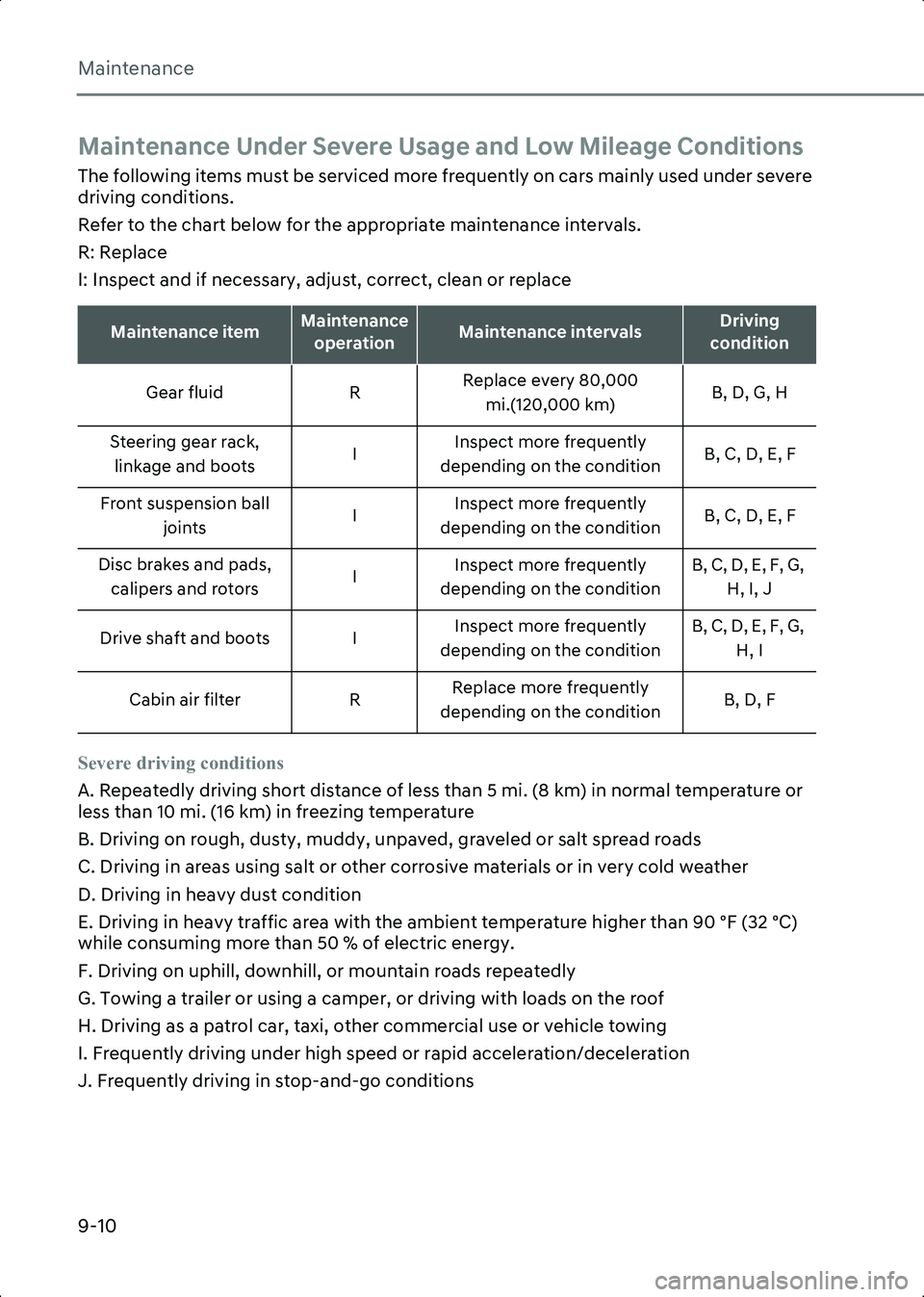
Maintenance
9-10
Maintenance Under Severe Usage and Low Mileage Conditions
The following items must be serviced more frequently on cars mainly used under severe
driving conditions.
Refer to the chart below for the appropriate maintenance intervals.
R: Replace
I: Inspect and if necessary, adjust, correct, clean or replace
Severe driving conditions
A. Repeatedly driving short distance of less than 5 mi. (8 km) in normal temperature or
less than 10 mi. (16 km) in freezing temperature
B. Driving on rough, dusty, muddy, unpaved, graveled or salt spread roads
C. Driving in areas using salt or other corrosive materials or in very cold weather
D. Driving in heavy dust condition
E. Driving in heavy traffic area with the ambient temperature higher than 90 ºF (32 ºC)
while consuming more than 50 % of electric energy.
F. Driving on uphill, downhill, or mountain roads repeatedly
G. Towing a trailer or using a camper, or driving with loads on the roof
H. Driving as a patrol car, taxi, other commercial use or vehicle towing
I. Frequently driving under high speed or rapid acceleration/deceleration
J. Frequently driving in stop-and-go conditions
Maintenance itemMaintenance operationMaintenance intervalsDriving
condition
Gear fluid RReplace every 80,000
mi.(120,000 km) B, D, G, H
Steering gear rack, linkage and boots IInspect more frequently
depending on the condition B, C, D, E, F
Front suspension ball joints IInspect more frequently
depending on the condition B, C, D, E, F
Disc brakes and pads, calipers and rotors IInspect more frequently
depending on the condition B, C, D, E, F, G,
H, I, J
Drive shaft and boots I Inspect more frequently
depending on the condition B, C, D, E, F, G,
H, I
Cabin air filter RReplace more frequently
depending on the condition B, D, F
Hyundai_CE_en_US.book Page 10
Page 536 of 582

Maintenance
9-20
Information
An inappropriately disposed battery can be
harmful to the environment and human health.
Dispose of the battery according to your local
law(s) or regulation.
Reset Items
The following items may need to be reset
after the battery has been discharged or
the battery has been disconnected:
• Drive info/After Recharging/Accumulated info (items in
View modes) (refer to chapter 4)
• Integrated Memory System (refer to chapter 5)
• Power Windows (refer to chapter 5)
• Wide Sunroof (if equipped) (refer to chapter 5)
• Power Trunk (refer to chapter 5)
• Automatic Climate Control System (refer to chapter 5)
• Clock (refer to the Infotainment system manual)
• Infotainment System (refer to the Infotainment system manual)
Tires and Wheels
WARNING Tire failure may cause loss of vehicle
control resulting in an accident. To
reduce risk of SERIOUS INJURY or
DEATH, take the following
precautions:
• Inspect your tires monthly for proper inflation as well as wear and
damage.
• The recommended cold tire pressure for your vehicle can be
found in this manual and on the tire
label located on the driver’s side
center pillar. Always use a tire
pressure gauge to measure tire
pressure. Tires with too much or
too little pressure wear unevenly
causing poor handling.
• Check the pressure of the spare every time you check the pressure
of the other tires on your vehicle.
• Replace tires that are worn, show uneven wear, or are damaged.
Worn tires can cause loss of braking
effectiveness, steering control, or
traction.
• ALWAYS replace tires with the same size, type, construction and
tread pattern as each tire that was
originally supplied with this vehicle.
Using tires and wheels other than
the recommended sizes could
cause unusual handling
characteristics, poor vehicle
control, or negatively affect your
vehicle’s Anti-Lock Brake System
(ABS) resulting in a serious
accident.
Hyundai_CE_en_US.book Page 20
Page 545 of 582
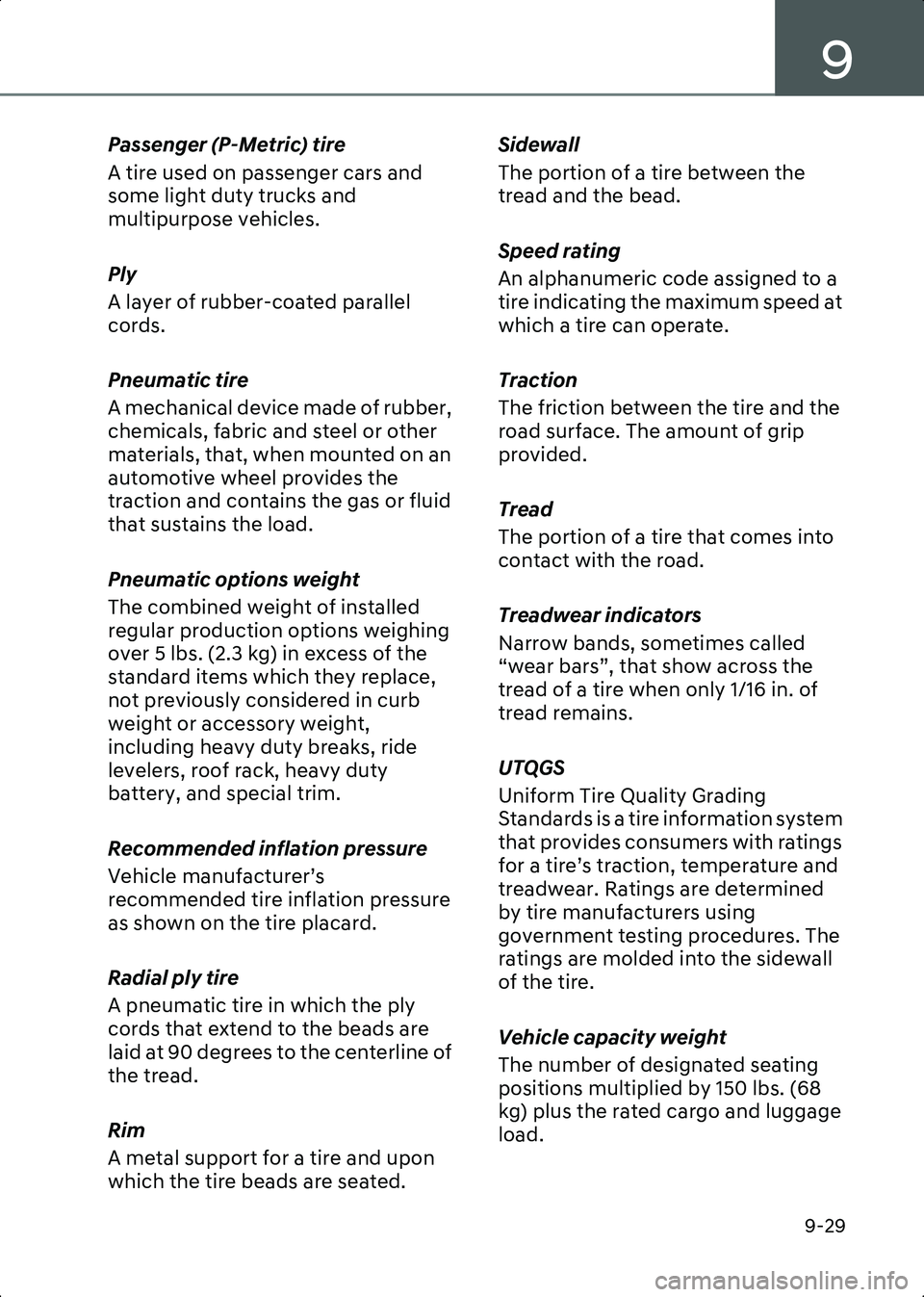
9
9-29
Passenger (P-Metric) tire
A tire used on passenger cars and
some light duty trucks and
multipurpose vehicles.
Ply
A layer of rubber-coated parallel
cords.
Pneumatic tire
A mechanical device made of rubber,
chemicals, fabric and steel or other
materials, that, when mounted on an
automotive wheel provides the
traction and contains the gas or fluid
that sustains the load.
Pneumatic options weight
The combined weight of installed
regular production options weighing
over 5 lbs. (2.3 kg) in excess of the
standard items which they replace,
not previously considered in curb
weight or accessory weight,
including heavy duty breaks, ride
levelers, roof rack, heavy duty
battery, and special trim.
Recommended inflation pressure
Vehicle manufacturer’s
recommended tire inflation pressure
as shown on the tire placard.
Radial ply tire
A pneumatic tire in which the ply
cords that extend to the beads are
laid at 90 degrees to the centerline of
the tread.
Rim
A metal support for a tire and upon
which the tire beads are seated.Sidewall
The portion of a tire between the
tread and the bead.
Speed rating
An alphanumeric code assigned to a
tire indicating the maximum speed at
which a tire can operate.
Traction
The friction between the tire and the
road surface. The amount of grip
provided.
Tread
The portion of a tire that comes into
contact with the road.
Treadwear indicators
Narrow bands, sometimes called
“wear bars”, that show across the
tread of a tire when only 1/16 in. of
tread remains.
UTQGS
Uniform Tire Quality Grading
Standards is a tire information system
that provides consumers with ratings
for a tire’s traction, temperature and
treadwear. Ratings are determined
by tire manufacturers using
government testing procedures. The
ratings are molded into the sidewall
of the tire.
Vehicle capacity weight
The number of designated seating
positions multiplied by 150 lbs. (68
kg) plus the rated cargo and luggage
load.
Hyundai_CE_en_US.book Page 29
Page 554 of 582
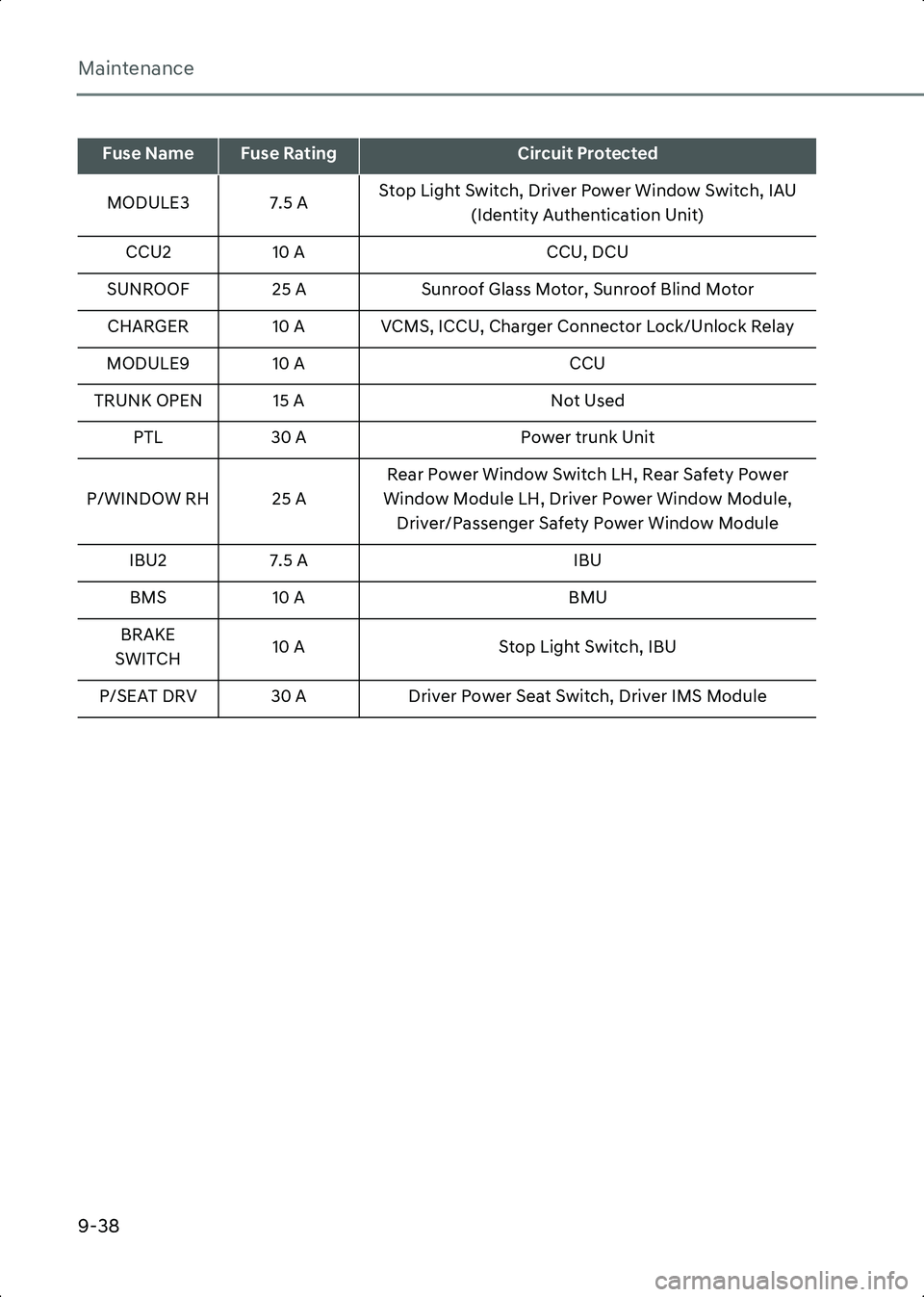
Maintenance
9-38
MODULE3 7.5 AStop Light Switch, Driver Power Window Switch, IAU
(Identity Authentication Unit)
CCU2 10 A CCU, DCU
SUNROOF 25 A Sunroof Glass Motor, Sunroof Blind Motor
CHARGER 10 A VCMS, ICCU, Charger Connector Lock/Unlock Relay
MODULE9 10 A CCU
TRUNK OPEN 15 A Not Used
PTL 30 A Power trunk Unit
P/WINDOW RH 25 A Rear Power Window Switch LH, Rear Safety Power
Window Module LH, Driver Power Window Module, Driver/Passenger Safety Power Window Module
IBU2 7.5 A IBU
BMS 10 A BMU
BRAKE
SWITCH 10 A
Stop Light Switch, IBU
P/SEAT DRV 30 A Driver Power Seat Switch, Driver IMS Module
Fuse NameFuse RatingCircuit Protected
Hyundai_CE_en_US.book Page 38
Page 573 of 582
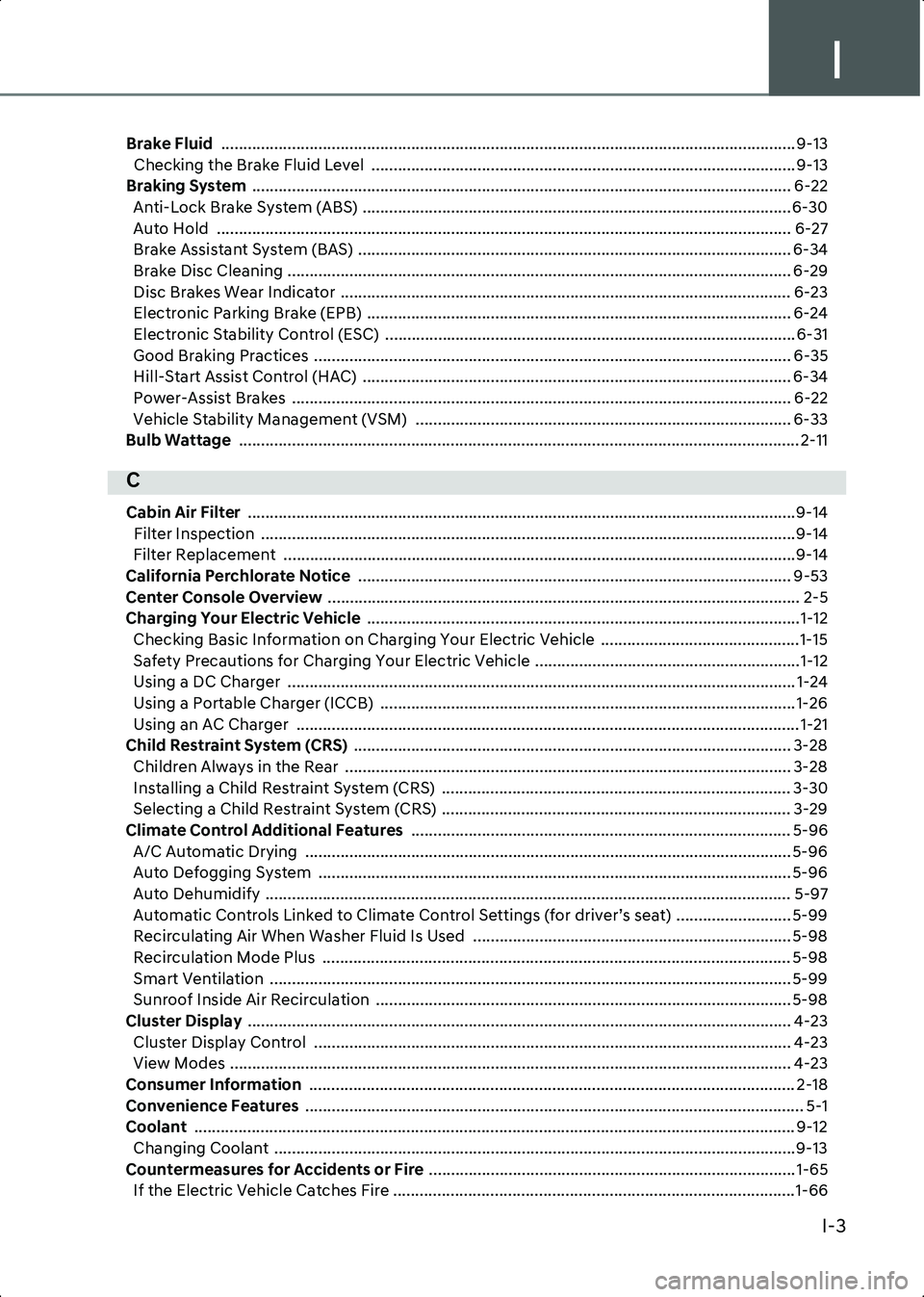
I
I-3
Brake Fluid .................................................................................................................................. 9-13
Checking the Brake Fluid Level ................................................................................................ 9-13
Braking System .......................................................................................................................... 6-22
Anti-Lock Brake System (ABS) ................................................................................................. 6-30
Auto Hold .................................................................................................................................. 6-27
Brake Assistant System (BAS) .................................................................................................. 6-34
Brake Disc Cleaning .................................................................................................................. 6-29
Disc Brakes Wear Indicator ...................................................................................................... 6-23
Electronic Parking Brake (EPB) ................................................................................................ 6-24
Electronic Stability Control (ESC) ............................................................................................. 6-31
Good Braking Practices ............................................................................................................ 6-35
Hill-Start Assist Control (HAC) ................................................................................................. 6-34
Power-Assist Brakes ................................................................................................................. 6-22
Vehicle Stability Management (VSM) ..................................................................................... 6-33
Bulb Wattage ............................................................................................................................... 2-11
C
Cabin Air Filter ............................................................................................................................9-14
Filter Inspection .........................................................................................................................9-14
Filter Replacement ....................................................................................................................9-14
California Perchlorate Notice .................................................................................................. 9-53
Center Console Overview ........................................................................................................... 2-5
Charging Your Electric Vehicle ..................................................................................................1-12
Checking Basic Information on Charging Your Electric Vehicle .............................................1-15
Safety Precautions for Charging Your Electric Vehicle ............................................................1-12
Using a DC Charger ................................................................................................................... 1-24
Using a Portable Charger (ICCB) .............................................................................................. 1-26
Using an AC Charger .................................................................................................................. 1-21
Child Restraint System (CRS) ................................................................................................... 3-28
Children Always in the Rear ..................................................................................................... 3-28
Installing a Child Restraint System (CRS) ............................................................................... 3-30
Selecting a Child Restraint System (CRS) ............................................................................... 3-29
Climate Control Additional Features ...................................................................................... 5-96
A/C Automatic Drying .............................................................................................................. 5-96
Auto Defogging System ........................................................................................................... 5-96
Auto Dehumidify ....................................................................................................................... 5-97
Automatic Controls Linked to Climate Control Settings (for driver’s seat) .......................... 5-99
Recirculating Air When Washer Fluid Is Used ........................................................................ 5-98
Recirculation Mode Plus .......................................................................................................... 5-98
Smart Ventilation ...................................................................................................................... 5-99
Sunroof Inside Air Recirculation .............................................................................................. 5-98
Cluster Display ........................................................................................................................... 4-23
Cluster Display Control ............................................................................................................ 4-23
View Modes ............................................................................................................................... 4-23
Consumer Information .............................................................................................................. 2-18
Convenience Features ................................................................................................................. 5-1
Coolant ........................................................................................................................................ 9-12
Changing Coolant ...................................................................................................................... 9-13
Countermeasures for Accidents or Fire ................................................................................... 1-65 If the Electric Vehicle Catches Fire ...........................................................................................1-66
Hyundai_CE_en_US.book Page 3
Page 581 of 582
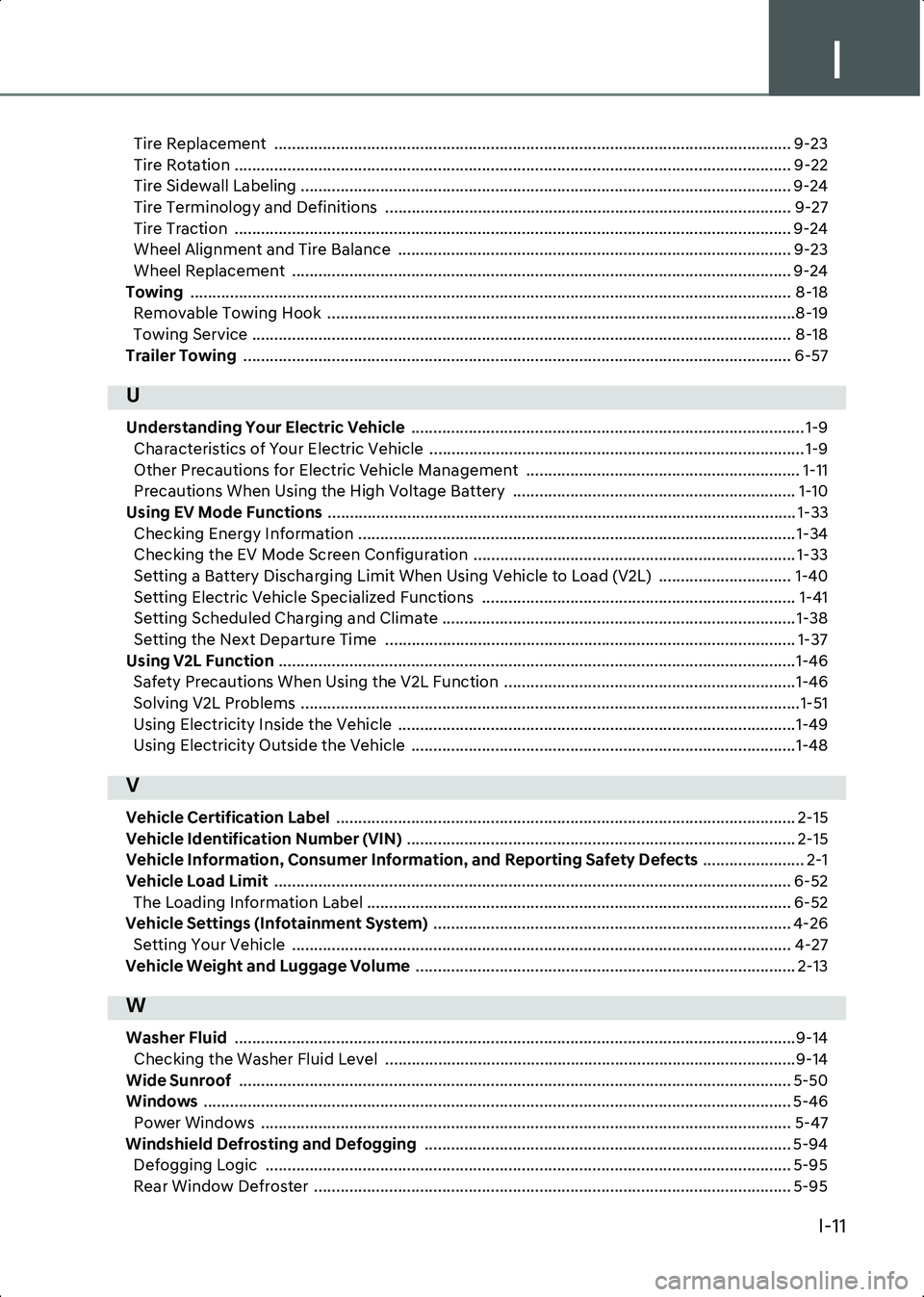
I
I-11
Tire Replacement ..................................................................................................................... 9-23
Tire Rotation .............................................................................................................................. 9-22
Tire Sidewall Labeling ............................................................................................................... 9-24
Tire Terminology and Definitions ............................................................................................ 9-27
Tire Traction .............................................................................................................................. 9-24
Wheel Alignment and Tire Balance ......................................................................................... 9-23
Wheel Replacement ................................................................................................................. 9-24
Towing ........................................................................................................................................ 8-18
Removable Towing Hook ..........................................................................................................8-19
Towing Service .......................................................................................................................... 8-18
Trailer Towing ............................................................................................................................ 6-57
U
Understanding Your Electric Vehicle ......................................................................................... 1-9
Characteristics of Your Electric Vehicle .....................................................................................1-9 Other Precautions for Electric Vehicle Management .............................................................. 1-11
Precautions When Using the High Voltage Battery ................................................................ 1-10
Using EV Mode Functions .......................................................................................................... 1-33
Checking Energy Information ................................................................................................... 1-34
Checking the EV Mode Screen Configuration ......................................................................... 1-33
Setting a Battery Discharging Limit When Using Vehicle to Load (V2L) .............................. 1-40
Setting Electric Vehicle Specialized Functions ....................................................................... 1-41
Setting Scheduled Charging and Climate ................................................................................ 1-38
Setting the Next Departure Time ............................................................................................. 1-37
Using V2L Function .....................................................................................................................1-46
Safety Precautions When Using the V2L Function ..................................................................1-46
Solving V2L Problems .................................................................................................................1-51 Using Electricity Inside the Vehicle ..........................................................................................1-49
Using Electricity Outside the Vehicle .......................................................................................1-48
V
Vehicle Certification Label ........................................................................................................ 2-15
Vehicle Identification Number (VIN) ........................................................................................ 2-15
Vehicle Information, Consumer Information, and Reporting Safety Defects ....................... 2-1
Vehicle Load Limit ..................................................................................................................... 6-52
The Loading Information Label ................................................................................................ 6-52
Vehicle Settings (Infotainment System) ................................................................................. 4-26
Setting Your Vehicle ................................................................................................................. 4-27
Vehicle Weight and Luggage Volume ...................................................................................... 2-13
W
Washer Fluid ...............................................................................................................................9-14
Checking the Washer Fluid Level .............................................................................................9-14
Wide Sunroof ............................................................................................................................. 5-50
Windows ..................................................................................................................................... 5-46
Power Windows ........................................................................................................................ 5-47
Windshield Defrosting and Defogging ................................................................................... 5-94
Defogging Logic ....................................................................................................................... 5-95
Rear Window Defroster ............................................................................................................ 5-95
Hyundai_CE_en_US.book Page 11